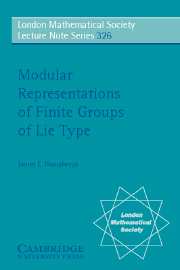Book contents
- Frontmatter
- Contents
- Preface
- 1 Finite Groups of Lie Type
- 2 Simple Modules
- 3 Weyl Modules and Lusztig's Conjecture
- 4 Computation of Weight Multiplicities
- 5 Other Aspects of Simple Modules
- 6 Tensor Products
- 7 BN-Pairs and Induced Modules
- 8 Blocks
- 9 Projective Modules
- 10 Comparison with Frobenius Kernels
- 11 Cartan Invariants
- 12 Extensions of Simple Modules
- 13 Loewy Series
- 14 Cohomology
- 15 Complexity and Support Varieties
- 16 Ordinary and Modular Representations
- 17 Deligne–Lusztig Characters
- 18 The Groups G2(q)
- 19 General and Special Linear Groups
- 20 Suzuki and Ree Groups
- Bibliography
- Frequently Used Symbols
- Index
11 - Cartan Invariants
Published online by Cambridge University Press: 23 November 2009
- Frontmatter
- Contents
- Preface
- 1 Finite Groups of Lie Type
- 2 Simple Modules
- 3 Weyl Modules and Lusztig's Conjecture
- 4 Computation of Weight Multiplicities
- 5 Other Aspects of Simple Modules
- 6 Tensor Products
- 7 BN-Pairs and Induced Modules
- 8 Blocks
- 9 Projective Modules
- 10 Comparison with Frobenius Kernels
- 11 Cartan Invariants
- 12 Extensions of Simple Modules
- 13 Loewy Series
- 14 Cohomology
- 15 Complexity and Support Varieties
- 16 Ordinary and Modular Representations
- 17 Deligne–Lusztig Characters
- 18 The Groups G2(q)
- 19 General and Special Linear Groups
- 20 Suzuki and Ree Groups
- Bibliography
- Frequently Used Symbols
- Index
Summary
The Cartan invariants of a group algebra KG (or other finite dimensional algebra) are the multiplicities of simple modules as composition factors of the principal indecomposable modules. If a set Λ (ordered in some way) indexes the isomorphism classes of simple modules Lλ and their projective covers Uλ, the resulting |Λ| × |Λ| Cartan matrixC has entries cλμ := [Uλ : Lμ]. (There should be no confusion with the use of “Cartan matrix” in the context of root systems.)
For a group of Lie type there are two overlapping questions: Can one actually compute the matrix C for a specific group or family of groups? Can one find meaningful patterns in the entries of C, such as uniformities for a Lie type when p is sufficiently large?
After reviewing some general facts about Cartan invariants for a group algebra (11.1–11.3), we shall discuss what is known in the case of finite groups of Lie type, with emphasis on “generic” behavior for large p (11.9–11.11). We then survey the known computations and exhibit some small explicit examples, updating the 1985 survey [228]. The chapter concludes with a look at some recent conjectures involving block invariants.
Cartan Invariants for Finite Groups
If G is any finite group, consider the simple KG-modules Lλ (indexed by some set Λ) and their projective covers Uλ. Denote the composition factor multiplicities by cλμ = [Uλ : Lμ]. These are the Cartan invariants, forming a |Λ| × |Λ| matrix C.
- Type
- Chapter
- Information
- Modular Representations of Finite Groups of Lie Type , pp. 101 - 114Publisher: Cambridge University PressPrint publication year: 2005
- 1
- Cited by

